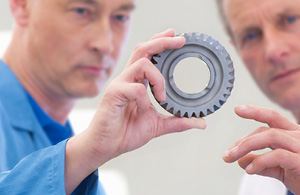Blasting systems are real all-rounders – whether it be derusting, roughening or mattifying
Depending on the method and blast agent used, surfaces can be processed to suit every requirement
Blasting systems are an inseparable part of surface technology, however they carry out the most varied tasks. The choice of blast system is also important. In combination with the right blast agent, a wide variety of effects can be achieved on surfaces. SIGG blast technology produces a range of different blasting systems and also offers blast agents for them. In our in-house test laboratory, professionals experiment until the best blasting systems are found for every customer order. And if there are no suitable blasting systems, SIGG will even build specialist systems and equipment that is perfectly tailored to the customer's needs.
Blasting systems work according to three key principles
A distinction is made in blasting technology between primarily three principles: the pressure blast method, the injector blast method and the wet blasting or whitewash blasting method.
Pressure blast method
With this blasting method, the blast agent is collected in a blast pot. The pot is pressurised. At the same time, compressed air is transported through an air line underneath the pot. In a mixing pipe, the blast agent and compressed air are combined. The speed of the flow remains the same. It is only in the next section that the cross-section of the pipeline is reduced, increasing the flow speed of the mixture. At 4 bar of pressure, the blast speed of the blast systems reaches around 250 m/s. However blasting can also be carried out at lower pressures - the pressurised blasting method covers a wide range of blasting variations.
Injector blast method
The injector blast method is the most commonly used blasting method these days, and is based on the following principle: compressed air is forced through an air nozzle and guided into a blast nozzle. The reduction in the cross section reduces the flow. In the blast gun, the blast agent is aspirated based on the Venturi principle. The Venturi principle is based on a narrowing in the flow area, which generates a vacuum in the pick-up pipe. This vacuum sucks up the blast agent. As a result, the blast pressure and volume of blast agent are inter-dependent: the less compressed air there is flowing, the less blast agent is sucked into the blast system.
Wet blasting
In this case, water, compressed air and the blast agent all meet in the blast system. The blast agent and water are mixed in the pot. The surface tension of the water surrounds each grain of blast agent with a sphere of water. This water sphere protects the tubes and nozzles and improves flow behaviour. The blast agent, pressure and water element can be changed at will. This means that noble metals, for which ideally as little of the surface is to be removed as possible, can also be improved.
Which blast system is the right one for you? Simply give us a call or send us an e-mail - we’ll be happy to advise you! +49 (0) 7741 808 93 0 or e-mail info(at)sigg-strahltechnik(dot)de.



![[Translate to Englisch:] SIGG Strahltechnik [Translate to Englisch:] SIGG Strahltechnik](/fileadmin/user_upload/slider/slider_fullsize/Strahlanlagen/SIGG-Strahltechnik-Karussell-Strahlanlagen.jpg)

